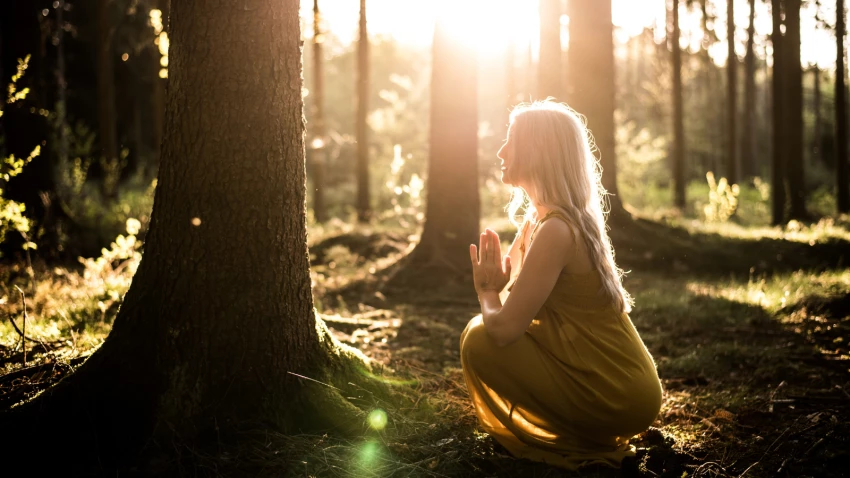Earth Element: Stand Your Ground
Grow Your Root System—Physically, Mentally, Emotionally and Spiritually

Article At A Glance
Earth A popular nursery rhyme from the early 19th century suggests that we are made of many things, “frogs, snails and puppy-dog tails” for boys, and “sugar, spice and everything nice” for girls. The Bible says, “ashes to ashes, dust to dust,” meaning that we come from dust are made of dust and will return to dust after transitioning from our five-sense material world.
In terms of the nursery rhyme, I’m hoping wiser heads have let that go. I personally know many sweet, spicy men and froggy, snail-like women. Although I understand the use of the word “dust,” I prefer the word “earth.” Dust, to me, is what you find under the sofa when you finally get around to cleaning up. Earth is what you plant seeds in to grow vegetables, plants, and flowers. It’s a much pleasanter way to think of yourself whether you are a man or a woman, or place yourself at some other point on the rainbow of human expression.
What Is the Earth Element?
In the next several posts, I plan to explore what we’re made of and how to use those ingredients to enlighten up. Let’s start with earth. We can look at it through three lenses—physical, energetic, and psychological.
As matter, earth exists as a solid state that we can see, hear, smell, touch, or taste. This includes our physical body and everything in and on it. It’s dirt, soil, and the things that grow out of it such as trees, mountains, the buildings we live and work in, and the planet we live on. Earth is a homey word that connotes a foundation from which to grow and blossom. No wonder we call our planet “The Earth.”
As energy earth possesses qualities we need in order to keep ourselves balanced and healthy. At its core earth energy is the force that stabilizes and holds things together. It’s permanent, heavy, slow-changing, slow-moving, downward flowing, dense, and enduring.
How to Stand Your Ground
Psychologically, we can think of the earth as having qualities of safety, stability, security, nurturance, and survival. To successfully connect with these qualities, we need to fully inhabit our earthly bodies with compassion and without judgment—no matter their condition or ability. An example of language that sharpens this connection is the phrase “stand your ground.” Finding ways to stand our ground in these troubled times is a challenge whether due to race, religion, ability, gender, health issues, political affiliation, body image, etc.
Earth Element Energy Depends on Meeting Basic Needs
It’s also hard to stand your ground energetically and psychologically if your basic physical needs have not been met. Consider Maslow’s hierarchy of human needs:
- Air, water, and food
- Safety (ex. clothing, shelter, security)
- Social connection
- Self-esteem
- Self-actualization
Having sufficient air, water, food, and safety establishes a personal root system that helps us grow toward positive social connections, self-esteem, and self-actualization. Feeling comfortable and at home in your own skin can be an indication that your connection to the earth through all three lenses is balanced. This is evident when you feel stable, compassionate, or calm, and when you feel safe and connected to the physical world, your family, friends, and support communities.
The additional stress many of us deal with these days often manifests as issues that challenge our ability to keep this balance. In order to stand our ground, we need to restore that all-important sense of safety and security.
How to Nurture Your Earth Element
Here are two accessible practices that can help.
Grounding
 “Earthing” is the practice of grounding or connecting directly with the earth through skin contact with bare feet or hands. Earthing can encourage and deepen feelings of safety, security, and connection. You can read more about the practice here.
“Earthing” is the practice of grounding or connecting directly with the earth through skin contact with bare feet or hands. Earthing can encourage and deepen feelings of safety, security, and connection. You can read more about the practice here.
Those of us able to stand firmly on our own two feet, walk barefoot in the grass or on the sand at the beach can experience grounding through direct connection with the earth. If we are able to transfer from standing to sitting or lying down we connect even more of our body to the earth.
But what if you are unable to transfer up and down off the floor or connect your body directly to the ground? What if your feet go no further than wheelchair footrests or if parts of your body are missing or movement is limited due to surgery or a health condition? Where there is a will, there is always a way. Missing or non-functioning body parts can still be experienced energetically. If this is your lived experience, try the Roots Visualization instead.
Earth Element: Roots Visualization

1. Direct your attention to your legs and feet (physical or energetic) to sense a deeper connection to the earth, floor, or wheelchair footrests beneath you.
2. Begin to visualize roots growing from your body, starting from the base of the spine. Feel roots reaching down through your legs through the bottoms of your feet to pierce through the earth’s crust.
3. Visualize your roots branching and spreading, growing stronger and reaching deeper into the earth. Sense the strength, support, and the stability your branching roots send back to fill your entire body.
4. With each inhalation, begin to draw in strength, support, and stability. Allow the feeling to deepen your connection to the physical world and your place in it.
5. Draw the quality of grounding through the bones of your feet and legs to the base of your spine, all the way up to the crown of your head. Feel your entire body safe, secure, stable, and connected.
You can shorten or lengthen the visualization as needed to stand your ground assertively, authentically, and confidently connect to your world and earth in all of its forms.
Also, read...
Teaching Svadhyaya: 3 Ways to Encourage Self-Study in Yoga
In Celebration of Gray-Haired Yoga – Busting the Myth of the Yoga Body
Related courses

Beth Gibbs, MA, is a faculty member at the Kripalu School of Integrative Yoga Therapy. She holds a master’s degree in Yoga Therapy and Mind/Body Health from Lesley University in Cambridge, MA. She is the author of Soul Food, Life-Affirming Stories Served with Side Dishes and Just Desserts, Enlighten Up! Finding Clarity, Contentment, and Resilience in a Complicated World and Ogi Bogi, The Elephant Yogi, a therapeutic yoga book for children. Beth is an experienced workshop leader and public speaker. She blogs at bethgibbs.com



